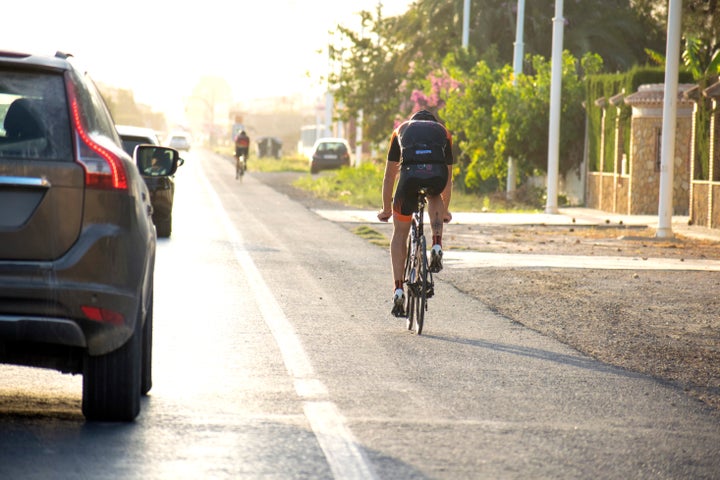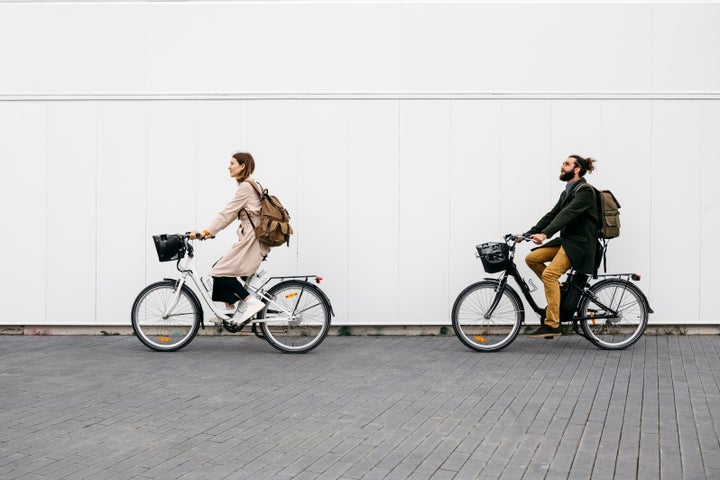We’re here to guide you through the coronavirus lockdown. Sign up to the Life newsletter for daily tips, advice, how-tos and escapism.
In a post-lockdown world, many people will look for new ways to commute to keep their distance from others. A popular solution? Cycling.
It’s already on people’s minds, as more than a third say they’ll rethink the way they travel after the pandemic, a survey by charity Cycling UK found. And it’s not surprising, given that the government has urged people to go back to work, but avoid public transport.
Cycling to work seems like a no-brainer if you don’t have a lengthy commute: it’s faster than walking, you’re outdoors where the likelihood of coronavirus spreading is reduced, and it’s better for the planet.
It’s also beneficial for your health. Analysis of data from 300,000 commuters in England and Wales between 1991 and 2016 found those who cycled to work had a 20% reduced rate of early death compared to those who drove.
Improved infrastructure is on its way, too. The Department for Transport recently announced a £2bn package to create a “new era for cycling and walking”.
Pop-up bike lanes, wider pavements, safer junctions, and cycle and bus-only corridors have been promised in England, as part of the ambitious aim to double cycling and increase walking by 2025.
So, you’re thinking of getting on the bicycle bandwagon. Now what? Use our six-point guide to get bike ready.
1. Find the best bike for you
Cycling doesn’t have to be expensive, so don’t fork out loads if you’re a newbie. If you live in a city, look up bike sharing schemes to begin with – such as Santander Bikes, Lime, Jump, Freebike, Beryl – to check cycling is for you. Just make sure you take anti-bacterial wipes to give the handlebars a clean.
If you’re committed to buying your own bike, start conversations with friends who cycle, or look online to see what might suit you. Got three minutes to spare? Watch this YouTube video from the Cycling Experts on the different styles of bike for different purposes.
Hybrid bikes – those with characteristics from road bikes, touring bikes and mountain bikes – are good all-around cycles for commuting, recommends Bike Radar. They’re not the lightest or most comfortable bikes for long distances, though.
“Most modern hybrids are usually built around 700c wheels... the tyres are often wider than a road bike’s – but usually not as wide as a mountain bike – allowing you to traverse rough roads and gravel paths with ease,” they say.

If you live in a particularly hilly area, an e-bike might be a good option, giving you a boost and ensuring you don’t arrive at work looking like a sweaty mess. Folding bikes could be a good choice for those who have to balance public transport with two-wheel travel. It’s worth steering clear of Dutch-style bikes, though. While aesthetically pleasing, they aren’t the best for a daily commute – they’re heavy so you’ll find it slow-going.
If you can, head to your local bike shop to discuss your options. “The important thing is that you choose a bike that’s comfortable for you and fully roadworthy,” Dame Sarah Storey, Paralympic champion and British Cycling Policy Advocate, tells HuffPost UK.
“And don’t be put off by the saddle on the bike, as these are easily interchangeable and all good bike shops will be able to advise on an alternative.”
2. Get clued up on basic safety
Staying safe on the road is incredibly important. Before you start, make yourself aware of the Highway Code. Dame storey advises new cyclists to always look ahead, anticipate hazards and signal any movements clearly.
Remind yourself of basic road positioning rules, too. Emily Brooke, CEO and founder of bike share scheme company Beryl, reminds new cyclists not to “cycle in the gutter”, as this can be dangerous. “The best position to take is riding one-third of the way into the lane as it discourages motorists from trying to pass you when there potentially isn’t a safe enough space,” she explains.
Turning in the road can be scary for beginners – especially when it involves moving in front of traffic. You can go about it in three stages, says Brooke: look, signal, manoeuvre. “Before you turn, slow down a little and look over your shoulder to get a clearer picture of what’s happening behind you,” she says.
“When you’ve assessed the situation and feel it’s safe to turn, signal with your arm showing which way you’re going to be going. It’s a good idea to wait a couple of seconds before manoeuvring and get eye contact with the motorist behind you, so they recognise you’re planning on turning.”

Don’t forget the safety of your actual bike – make sure it’s roadworthy and fitted with working lights when riding in low light. Your local bike store can help with this – they can give it a service if the bike is old or secondhand.
And one last point on safety: cycling coach Robert Evans warns against using headphones. ”You should never wear headphones while riding even if you think you can hear what is happening around you,” he told Essential Living.
“Cycling relies heavily on your sense of hearing to identify cars or other cyclists approaching. Headphones, even on a low volume, not only disrupt this sense, but if you were to get into a collision with a vehicle or pedestrian this could be used against you even if you are in the right.”
3. Choose your route and practise it
Before you start back at work, plan the route you’d take and do a few test runs while it’s less busy. That way, you can see how long your cycle commute will be, so you know how long to leave yourself to get to work at a leisurely pace. You don’t want to rock up to the office dripping with sweat, after all.
Brooke suggests looking into national cycle network routes, local cycle paths or quieter roads you can take. “This may mean your ride becomes slightly longer, but it will make the whole thing more enjoyable,” she says.

4. Build up your fitness
You may not be able to ride the full distance to work straight away if you’ve not cycled before, so don’t overstretch yourself. Instead, build up your distance gradually, suggests Craig Myers, British Cycling’s recreation manager.
“If you’re completely new to cycling and feel a little nervy, stick to parks or traffic-free routes to begin with and progress from there,” he says. “There’s no need to put yourself under any pressure. Cycling is a really accessible activity – you don’t have to be Geraint Thomas to enjoy getting out for a ride.”
5. Invest in basic bike accessories
There’s so much cycling gear out there, it’s hard to know where to start. Firstly, get some front and rear bike lights and reflective clothing so you’re visible in the dark. Brooke also recommends the Proviz REFLECT360 cycling backpack for commuters.
Will you wear a helmet? It’s a hotly debated topic and a question of individual choice – but a safe option. “There’s no British law to compel cyclists, of any age, to wear helmets when cycling, though it’s particularly recommended for young children and those who aren’t confident in their riding ability,” says Brooke.
You’ll want to be prepared for worst-case scenarios, like punctures or your chain falling off. Myers suggests carrying a spare inner tyre tube, tyre levers, a multi-tool and pump. Pick these up at your local bike shop and make sure you’re familiar with how to use them, too.
It’s also useful to have your phone on hand for directions (hello Google maps). Alternatively, Brooke recommends the Beeline Velo, a minimalist bike computer that directs you to your desired destination safely.

You’ll need a decent lock if you’ll be leaving your bike outside your work. The Kryptonite Keeper 12 Standard Lock comes highly recommended.
Brooke says it’s best to lock your bike in an extremely visible spot so frequent passers-by act as a theft deterrent. “Fill as much of the lock with as much of the bike as possible,” she says, “ensuring you include a wheel and part of the bike’s frame.”
6. Dress the part
You don’t have to dress head-to-toe in lycra. “If you’re going to be riding at a leisurely pace, you can probably do it in your work clothes,” says Dame Storey. “However, it’s important to make sure you’re protected from the elements, so get yourself a good breathable waterproof.” And check the forecast before heading out, so you know whether you’ll need it or not.
Trainers are a must and you might want to opt for cycle shorts or leggings if you don’t want your work trousers getting stuck in the chain or splashed with mud. If you’re finding you’re a bit saddle sore after a few journeys, invest in some padded shorts.
As part of its #ChooseCycling campaign, British Cycling has created a Commute Smart video series which aims to answer all of the questions beginners might have.
